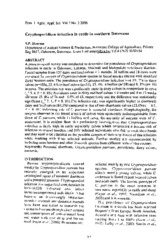Cryptosporidium infection in cattle in southern Botswana
Abstract
A parasitological survey was conducted to determine the prevalence of Cryptosporidium
infection in cattle in Gaborone, Lobatse, Mochudi and Molepolole veterinary districts.
Faecal samples from 137 dairy and beef calves < 3 months, 38 heifers and 36 cows were
examined for oocysts of Cryptosporidium species in faecal smears stained with modified
Ziehl Neelsen stain. The prevalence of Cryptosporidium infection was 29. 3% in dairy
calves (n=106), 22. 6% in beef calves (n=31), 15. 8% in heifers (n=38) and 8. 3% (n= 36)
in cows. The infection rate was significantly more in dairy calves in comparison to cows
(_2 5. 4, P < 0. 05). Prevalence rates in dairy and beef calves < 4 weeks and 4 to 13 weeks
old were 37. 8% of 74 and 15.9% of 63, respectively and the difference was statistically
significant (_2 7. 1, P < 0. 01).The infection rate was significantly higher in diarrhocic
dairy and beef calves (64.3%) compared to that of non-diarrhoeic calves (23.6%) (_~ 8.5,
P < 0. 01) indicating role of C. parvum in neonatal diarrhoea. Morphologically, the
oocysts observed in the faecal smears of calves were apparently indistinguishable from
those of C.parvum, while in heifers and cows, the majority of oocysts were of C.
andersoni. Il is evident from this preliminary investigation that Cryptosporidium
infection is fairly high in cattle especially calves which constitutes a serious risk of
infection to animal handlers and HIV infected individuals who fail to wash their hands
and they need to be educated on the possible dangers of their acquisition of this infection
while working with these infected animals. Further studies are recommended by
including more bovines and other livestock species from different parts of this country.

